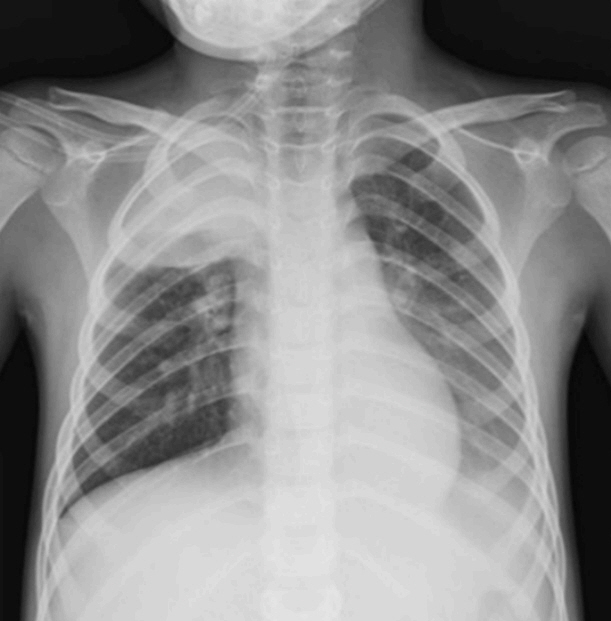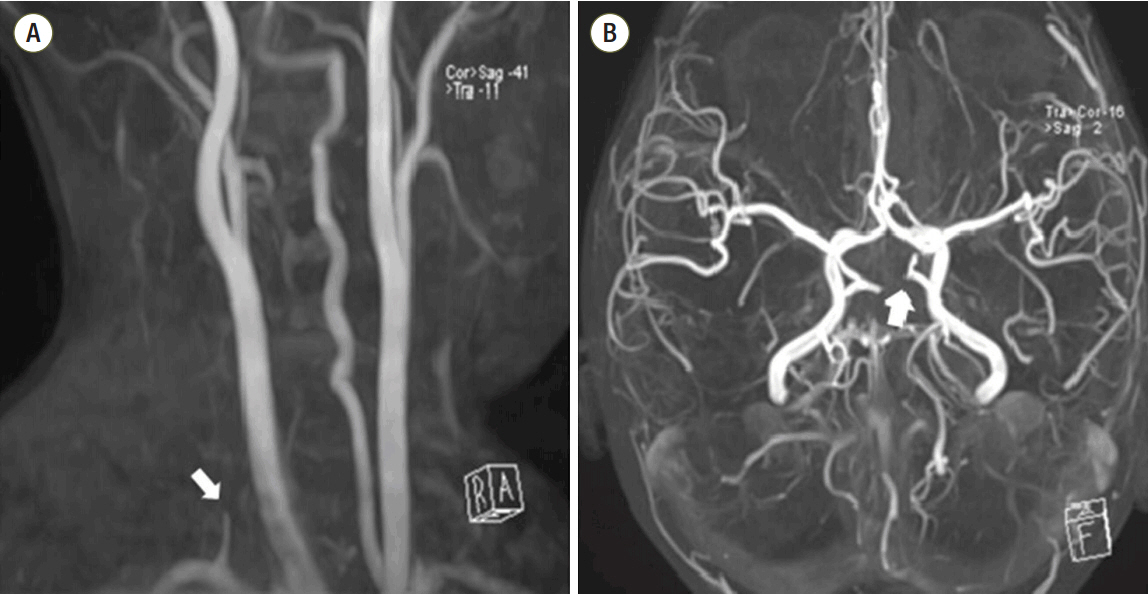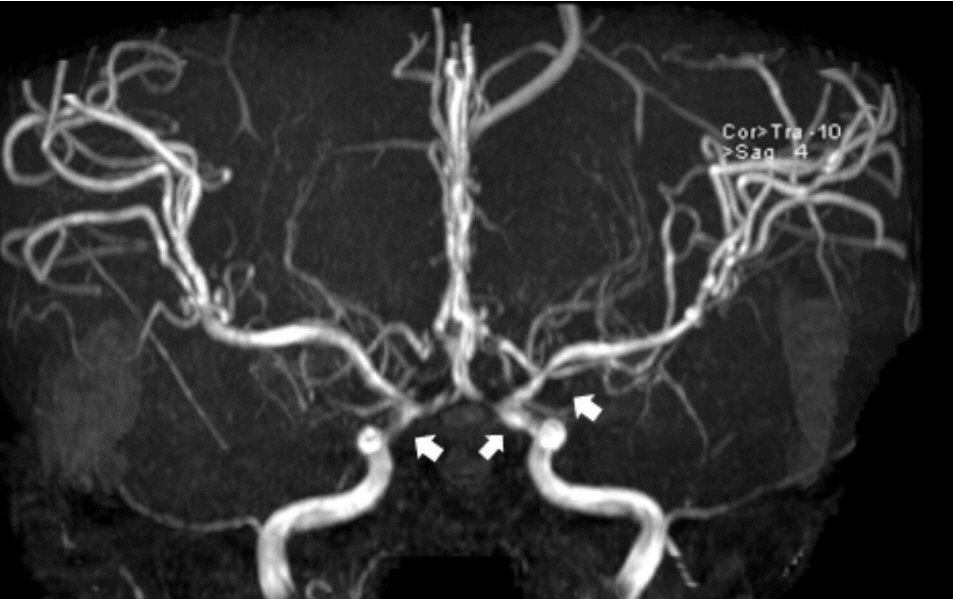Korean J Crit Care Med.
2017 May;32(2):211-217. 10.4266/kjccm.2016.00283.
Extensive and Progressive Cerebral Infarction after Mycoplasma pneumoniae Infection
- Affiliations
-
- 1Department of Pediatrics, Seoul National University College of Medicine, Seoul, Korea. jdparkmd@snu.ac.kr
- KMID: 2384047
- DOI: http://doi.org/10.4266/kjccm.2016.00283
Abstract
- Acute cerebral infarctions are rare in children, however, they can occur as a complication of a Mycoplasma pneumoniae (MP) infection due to direct invasion, vasculitis, or a hypercoagulable state. We report on the case of a 5-year-old boy who had an extensive stroke in multiple cerebrovascular territories 10 days after the diagnosis of MP infection. Based on the suspicion that the cerebral infarction was associated with a macrolide-resistant MP infection, the patient was treated with levofloxacin, methyl-prednisolone, intravenous immunoglobulin, and enoxaparin. Despite this medical management, cerebral vascular narrowing progressed and a decompressive craniectomy became necessary for the patient's survival. According to laboratory tests, brain magnetic resonance imaging, and clinical manifestations, the cerebral infarction in this case appeared to be due to the combined effects of hypercoagulability and cytokineinduced vascular inflammation.
MeSH Terms
Figure
Reference
-
References
1. Tsiodras S, Kelesidis I, Kelesidis T, Stamboulis E, Giamarellou H. Central nervous system manifestations of Mycoplasma pneumoniae infections. J Infect. 2005; 51:343–54.
Article2. Ovetchkine P, Brugieres P, Seradj A, Reinert P, Cohen R. An 8-old boy with acute stroke and radiological signs of cerebral vasculitis after recent Mycoplasma pneumoniae infection. Scand J Infect Dis. 2002; 34:307–9.3. Ryu JS, Kim HJ, Sung IY, Ko TS. Posterior cerebral artery occlusion after Mycoplasma pneumoniae infection associated with genetic defect of MTHFR C677T. J Child Neurol. 2009; 24:891–4.4. Leonardi S, Pavone P, Rotolo N, La Rosa M. Stroke in two children with Mycoplasma pneumoniae infection. A causal or casual relationship? Pediatr Infect Dis J. 2005; 24:843–5.5. Lee CY, Huang YY, Huang FL, Liu FC, Chen PY. Mycoplasma pneumoniae-associated cerebral infarction in a child. J Trop Pediatr. 2009; 55:272–5.
Article6. Fu M, Wong KS, Lam WW, Wong GW. Middle cerebral artery occlusion after recent Mycoplasma pneumoniae infection. J Neurol Sci. 1998; 157:113–5.
Article7. Tanir G, Aydemir C, Yilmaz D, Tuygun N. Internal carotid artery occlusion associated with Mycoplasma pneumoniae infection in a child. Turk J Pediatr. 2006; 48:166–71.8. Parker P, Puck J, Fernandez F. Cerebral infarction associated with Mycoplasma pneumoniae. Pediatrics. 1981; 67:373–5.
Article9. Visudhiphan P, Chiemchanya S, Sirinavin S. Internal carotid artery occlusion associated with Mycoplasma pneumoniae infection. Pediatr Neurol. 1992; 8:237–9.
Article10. Antachopoulos C, Liakopoulou T, Palamidou F, Papathanassiou D, Youroukos S. Posterior cerebral artery occlusion associated with Mycoplasma pneumoniae infection. J Child Neurol. 2002; 17:55–7.
Article11. Kim GH, Seo WH, Je BK, Eun SH. Mycoplasma pneumoniae associated stroke in a 3-year-old girl. Korean J Pediatr. 2013; 56:411–5.12. Papaevangelou V, Falaina V, Syriopoulou V, Theodordou M. Bell’s palsy associated with Mycoplasma pneumoniae infection. Pediatr Infect Dis J. 1999; 18:1024–26.
Article13. Kim EK, Youn YS, Rhim JW, Shin MS, Kang JH, Lee KY. Epidemiological comparison of three Mycoplasma pneumoniae pneumonia epidemics in a single hospital over 10 years. Korean J pediatr. 2015; 58:172–7.14. Morozumi M, Iwata S, Hasegawa K, Chiba N, Takayanagi R, Matsubara K, et al. Increased macrolide resistance of Mycoplasma pneumoniae in pediatric patients with community-acquired pneumonia. Antimicrob Agents Chemother. 2008; 52:348–50.15. Suzuki S, Yamazaki T, Narita M, Okazaki N, Suzuki I, Andoh T, et al. Clinical evaluation of macrolide-resistant Mycoplasma pneumoniae. Antimicrob Agents Chemother. 2006; 50:709–12.16. Yang J, Hooper WC, Phillips DJ, Talkington DF. Cytokines in Mycoplasma pneumonia infection. Cytokine Growth Factor Rev. 2004; 15:157–68.17. Miyashita N, Akaike H, Teranishi H, Ouchi K, Okimoto N. Macrolide-resistant Mycoplasma pneumoniae pneumonia in adolescents and adults: clinical findings, drug susceptibility, and therapeutic efficacy. Antimicrob Agents Chemother. 2013; 57:5181–5.
Article18. Macovei L, Gurzu A, Alexandrescu DM, Georgescu CA. Simultaneous tromboembolic events in a patient with heterozygous MTHFR mutation. Int Arch Med. 2015; 8.
Article19. Alba MA, Espígol-Frigolé G, Prieto-González S, Tavera-Bahillo I, García-Martínez A, Butjosa M, et al. Central nervous system vasculitis: still more questions than answers. Curr Neuropharmacol. 2011; 9:437–48.20. Lukán N. Intravenous immunoglobulin therapy in primary vasculitides. In : Amezcua-Guerra LM, editor. Advances in the diagnosis and treatment of vasculitis. 4th ed. Rijeka: InTech;2011. p. 149–66.
- Full Text Links
- Actions
-
Cited
- CITED
-
- Close
- Share
- Similar articles
-
- A Case of Cerebral Infarction Complicated by Mycoplasma pneumoniae Pneumonia
- A Case of Cerebral Infarction Associated with Mycoplasma pneumoniae infection
- A Case of Cerebral Infarction Associated with Mycoplasma pneumoniae Infection
- Epidemiology of Mycoplasma pneumoniae Infection in Childhood
- A Case of Erythema Multiforme in Adults Associated with Mycoplasma pneumoniae Infection





